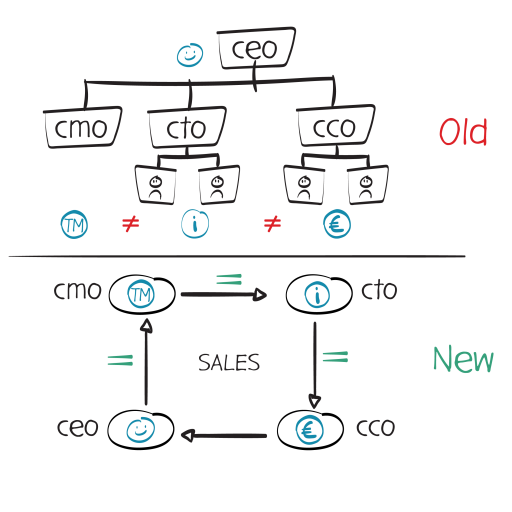Why are so many organization unable to adapt to a changing market place? Well according to my (Bart) research from 2010-2020, there are four main obstacles that prevent change in any organization. They are (1) the organizational structure of your organization (the linking-pin hierarchy), (2) the supporting systems that hold that structure in place (procedures and software), (3) the lack of support from your top 3 stakeholders and (4) the social status quo (the current culture).
1). social status quo e.g. culture
Let me start with the most dominant and important one: your organizational culture. If you recognize the following situation, it’s time for change. You ask a member of your management team, a colleague or department to do something differently and the first and primary response is: but we’ve always done it this way… ? That means your organization is in trouble. The most killing culture is one of conservative employees that want to hold on to procedures they know avoiding them to make mistakes. If you want to make sure your organization can adapt continuously to a changing environment, you need to make sure people start thinking in dynamic processes instead of static procedures. In other words: re-invent their proces at least each quarter to challenge the efficiency and effectiveness of it. If you want to know how you can do that, check out our GameStorm method. Otherwise, just read on and let me explain the other 3 obstacles that limit your organization to change and improve.

2) organizational structure
If your organization is divided into departments and silo’s, you’re in trouble too. If bosses and management have KPI’s that only take into account their own responsibilities and there is no mutual dependency with other departments, destructive competition is eminent. If you want to create a culture of collaboration (and you do), you need to take your key players and organize them around key-processes that support common goals. For instance, to create more sales, the Chief Marketing Officer will need insights from current buying behavior from the Chief Technical Officer (or CIO), to develop relevant propositions (together with the Chief Commercial Officer) in order to create happy consumers (and employees, when complaints drop and positive reviews rise). If the CCO has KPI’s like: maximize units sold and focus on margin, you might win the battle for revenue, but if the quality of the product is bad, deliveries too late, and returns rise… it kills your profit at the backdoor. Regrettably, the sales department is not often involved in product innovation or logistics, even if it influences their playing field.
3) lack of support
In any changing environment, like on a rough sea, people tend to departure the ship during harsh times. Sometimes by choice, more often not (man overboard). Did you know that negative people influence others with more impact than positive people can make up for? And that bad news, even fake news, travels faster and will spread out to more people?
How can you prevent people from turning negative? Find out what really moves them (spoiler alert: it’s not money). Determine whether they are motivated by ambitions, knowledge (rational), physical stuff (work environment, stuff, food) or social emotional factors and spiritual factors. There are serious games out there where people can determine their profile by playing a game. And if you know what motivates your employees, you can apply mechanics that will make them say yes. Check out which mechanics work well at our Youtube channel.
Another great way to create support is to involve them and actually make them direct the change you would like to see. For more information how to do this, please read how we can help you with that with our GameStorm method. We’ve applied it to the biggest sports retail chain in Europe with almost 20.000 employees and we played it with their 860 store managers. By no surprise the year after we introduced this method, the company had their biggest turn-over YTD during a time when many retailers actually went bankrupt!
4) systems that hold structure in place
I will be brief about this one, because it is a boring one. If you have systems in place that support a hierarchic structure (enforce reporting per department), get rid of them. These days you can develop custom software for prices that are the same as the license fees (and tailor made consultancy hours) you need to pay so called ’turn-key’ solutions. Obviously, we are fans of artificial intelligence, big data and gamification but only if it supports collaboration of teams throughout the whole organization. It is harder to make things simple than making them complex, but we encourage you to minimize reporting and let AI do the work for you. Use open-source software and see if you can narrow your business down to 4 KPI’s asking yourself the following questions:
I Do we develop enough relevant innovations (thinking proces) that are remarkable enough and relevant to our key stakeholders?
II How efficient (cheap) and effective (fast) is our development (making proces), can we deliver quality within the given constraints?
III Can we actually sell what we invent and create? If so, how fast, and can we scale up and if not, are we willing to kill this product or service and learn from this experience?
IV How can we improve this proces from thinking x making and selling, based on client- (retail) and customer feedback. How can we continuously level up from here… ?

Well, I hope this blog was inspiring and for our Dutch readers, if you want to learn more about this stuff. Read my book ‘Gamification als motor van verandering‘ or join our Masterclass Transformatie!
[Bart Hufen]